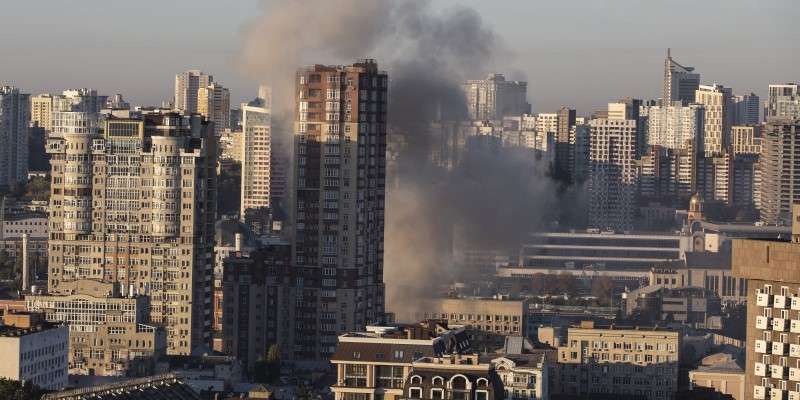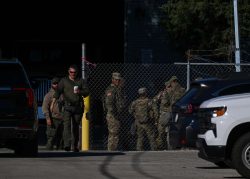
Rescue workers search the rubble of a residential building after a drone strike in Kyiv, Ukraine; four people were killed.
12:53 JST, October 18, 2022
KYIV, Ukraine – Russia redoubled its bombing of Ukrainian critical infrastructure Monday morning in a push to leave millions of people across the country without heat or power ahead of the winter, as a swarm of kamikaze drones attacked central Kyiv and missiles struck other cities.
In the capital, where residents awoke to the ominous sound of buzzing in the skies, a four-story residential building and an office building belonging to Ukraine’s electricity grid operator, Ukrenergo, next to the ST-1 thermal power station were hit.

Smoke rises after drone strikes in central Kyiv on Monday.
It was not immediately clear if the station itself – which serves four districts in central Kyiv – was hit. Any damage to it would leave thousands of people without power. Officials in the capital had already started rationing power, and urging residents to consume less, after a barrage of airstrikes a week ago hit energy targets, raising fears that Russia had opened a new chapter in the war.
The new strikes confirmed those fears and injected additional urgency into the pledges by Ukraine’s NATO supporters to strengthen air defenses, including with state-of-the-art systems. Intentionally directing attacks on civilian infrastructure with no military purpose is a war crime.

Kyiv Mayor Vitali Klitschko at a residential building that was partly destroyed in a strike by kamikaze drones on Monday.
Half of the residential building in Kyiv was destroyed, and emergency workers remained at the scene hours after the strikes. At least four people died in the blast, Kyiv Mayor Vitali Klitschko said. Two of the dead, he said, were a young couple that included a pregnant woman.
Klitschko, speaking to reporters at the scene, relayed a message to Russian President Vladimir Putin: “We Ukrainians will keep fighting for our freedom and for our independence. Everything that Putin is doing is genocide.”
Infrastructure facilities in other Ukrainian cities, including Odessa and Mykolaiv on the Black Sea, were also hit in the morning’s wave of attacks.
Russian Defense Ministry spokesman Igor Konashenkov said at a news briefing that Russian forces on Monday “continued strikes with long-range precision-guided air and sea-based weapons against Ukrainian military and energy system facilities.”
“All designated facilities have been hit,” he said.
Ukrenergo said that Monday’s strikes damaged energy infrastructure in central and northern Ukraine and that it was working to repair the damage. The operator did not rule out having to impose emergency power shutdowns and urged people to consume as little electricity as possible.
Russia’s strikes against Ukrainian infrastructure have stoked fears that people could be left without heat or power this winter.
Ukrainian Prime Minister Denys Shmyhal said on Telegram that “hundreds of settlements” lost power Monday because of the attacks, which also hit the central Dnipropetrovsk and northeastern Sumy regions. Emergency services agencies were working to restore electricity.
“All night and all morning, the enemy terrorizes the civilian population,” Ukrainian President Volodymyr Zelensky said Monday in a Telegram post. “Kamikaze drones and missiles are attacking all of Ukraine. A residential building was hit in Kyiv. The enemy can attack our cities, but it won’t be able to break us.”
Kyiv was hit Oct. 10 by a barrage of Russian attacks, after months without any strikes in the capital. Missiles landed near a downtown park, at a playground and at an office building near the same thermal station that was targeted again this Monday.
Last week’s strikes prompted calls from Ukrainian officials for allies to supply more air defense systems.
After the heart of the capital was hit again Monday, Mykhailo Podolyak, a senior adviser to Zelensky, called for Russia’s expulsion from “all platforms” of international diplomacy as a result of its attacks against “critical infrastructure to freeze civilians.”
The first explosions in Kyiv on Monday started at 6:45 a.m. People could hear the loud buzzing sound of the Iranian-made Shahed-136 drones – dubbed “flying mopeds” by Ukrainians for their loud engines – that Russia has been using.
As a second wave of drones swooped in about two hours later, law enforcement officers opened fire on them with small arms. The sound of gunfire could be heard throughout the city center. Personnel managed to shoot one down, according to Anton Gerashchenko, an adviser to Ukraine’s Interior Ministry.
In a video posted to his Telegram channel, he encouraged Ukrainian hunters and others who carry firearms to try shooting the drones if they spotted them. Interior Minister Denis Monastyrsky later asked gun owners to refrain from doing so.
Shahed-136 drones are capable of carrying precision-guided missiles and have a payload of about 110 pounds. Pentagon officials have publicly confirmed the use of Iranian drones in Russian airstrikes, as well as Ukraine’s success in shooting some of them down. Iran has repeatedly denied providing the drones to Russia.
A State Department spokesman, Vedant Patel, told reporters Monday that Moscow’s turn to Tehran underscores how badly Russian forces are “suffering from major supply shortages in Ukraine.” He noted a U.S. intelligence assessment, publicized last week, indicating that Russia has lost more than 6,000 pieces of military equipment since the war began in February.
Ukrainian Foreign Minister Dmytro Kuleba addressed European leaders from inside a bomb shelter Monday morning as an air-raid siren sounded throughout the country. He said on Twitter that he “called on EU to impose sanctions on Iran for providing Russia with drones. 9th EU sanctions package on Russia must be strong.”
Yuriy Ignat, a spokesman for Ukraine’s Air Force Command, said Ukrainian forces destroyed 26 Shahed drones from Sunday evening to Monday morning – including 15 between 3:30 and 7 a.m. local time Monday, according to the Ukrainian Pravda news outlet, which quoted Ignat’s comments to state television.
Russia has used kamikaze drones to attack military and infrastructure targets largely in southern Ukraine, and Monday marked the first time they were able to reach central Kyiv. The drones are typically less destructive than precision missiles – civilians can see and hear them coming, so they have more time to seek shelter before any explosion. And unlike with large missiles, the blast radius is smaller.
But they can also slip past Ukraine’s air defenses or force the military to use its limited air defense resources. As one Ukrainian captain in the Kyiv region who works with an S-300 surface-to-air missile system put it, taking out a drone with one of those missiles is “like firing a tank on one infantryman.”
“The effect is beautiful, but expensive,” Capt. Volodymyr Klymin said in a phone interview over the weekend. “Sometimes you don’t want to use one of these S-300 rockets on these little drones. But we understand that these little drones can cause a lot of damage, so unfortunately, without other forces, we have to use some of our strongest systems to fight these Shaheds.”
“We don’t have smaller, more-mobile air defense systems that would be more appropriate for them,” he added.
With thick smoke covering much of the capital’s downtown, people emerged from shelters early Monday after an air-raid alert that lasted some three hours. Some still headed to work. A coffee stand near the strike site continued to operate.

Mykyta Kryvko, 30, and his girlfriend Oksana Zinkovska, 31, carry their cats as residents evacuate an apartment building to take shelter after kamikaze drones strikes hit nearby in Kyiv on Monday.
Mykyta Kryvko, 30, and his girlfriend, Oksana Zinkovska, 31, had slept on a mattress pad “in case of emergency” in a corridor of their apartment. They live on the 22nd floor of a building directly across from the thermal station. After the first explosion, they grabbed their two cats and sheltered in the building’s underground parking garage.
Their windows, with tape already across them to protect from shattering glass, were still intact when they returned to the apartment. They faced the glass office building across the street that was damaged by a missile strike last week and was still without many windows.
Marina Koroban, 26, left Kyiv to stay with her parents in western Ukraine after last week’s missile strikes. She returned Saturday. “We have work here,” she said.
“Now we’re thinking of moving to a new neighborhood in Kyiv,” Koroban said. “There’s just a lot of infrastructure here. Our landlord wants to sell the apartment, but we told him no one will want to buy it right now.”
"News Services" POPULAR ARTICLE
-

American Playwright Jeremy O. Harris Arrested in Japan on Alleged Drug Smuggling
-

Japan’s Nikkei Stock Average as JGB Yields, Yen Rise on Rate-Hike Bets
-

Japan’s Nikkei Stock Average Licks Wounds after Selloff Sparked by BOJ Hike Bets (UPDATE 1)
-

Japan’s Nikkei Stock Average Buoyed by Stable Yen; SoftBank’s Slide Caps Gains (UPDATE 1)
-

Japanese Bond Yields Zoom, Stocks Slide as Rate Hike Looms
JN ACCESS RANKING
-

Tokyo Economic Security Forum to Hold Inaugural Meeting Amid Tense Global Environment
-

Keidanren Chairman Yoshinobu Tsutsui Visits Kashiwazaki-Kariwa Nuclear Power Plant; Inspects New Emergency Safety System
-

Imports of Rare Earths from China Facing Delays, May Be Caused by Deterioration of Japan-China Relations
-

University of Tokyo Professor Discusses Japanese Economic Security in Interview Ahead of Forum
-

Japan Pulls out of Vietnam Nuclear Project, Complicating Hanoi’s Power Plans
























